Uncategorized
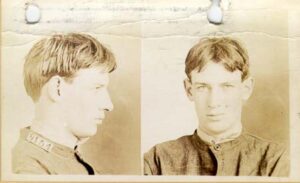
 First confined for killing a bartender in a brawl, Robert Stroud was sentenced to Leavenworth Federal Prison in Kansas, in 1909. His sentence was almost completed in 1916, when he stabbed a guard to death. Stroud claimed to have acted in self-defense, but in the end, he was convicted of the murder and sentenced to hang for the crime. Stroud’s mother was devastated, and she tried everything she could think of to have the sentence commuted to a lesser sentence. She was not having much success, until in desperation, she wrote a handwritten plea to President Woodrow Wilson, which finally earned Stroud a commuted sentence…with a twist. Stroud was now considered to be so dangerous that no one really wanted him to be allowed in the general population…especially not the guards. So, along with the sentence commutation came a stipulation…permanent solitary confinement. Most of us could not imagine spending the rest of our lives alone. The only people you might see would be a hand bringing you food. If that person chose not to be accommodating, they might not even speak to you, which means no true human contact. I don’t know if he had a television set later on, or a radio, but it could have been a very silent life.
First confined for killing a bartender in a brawl, Robert Stroud was sentenced to Leavenworth Federal Prison in Kansas, in 1909. His sentence was almost completed in 1916, when he stabbed a guard to death. Stroud claimed to have acted in self-defense, but in the end, he was convicted of the murder and sentenced to hang for the crime. Stroud’s mother was devastated, and she tried everything she could think of to have the sentence commuted to a lesser sentence. She was not having much success, until in desperation, she wrote a handwritten plea to President Woodrow Wilson, which finally earned Stroud a commuted sentence…with a twist. Stroud was now considered to be so dangerous that no one really wanted him to be allowed in the general population…especially not the guards. So, along with the sentence commutation came a stipulation…permanent solitary confinement. Most of us could not imagine spending the rest of our lives alone. The only people you might see would be a hand bringing you food. If that person chose not to be accommodating, they might not even speak to you, which means no true human contact. I don’t know if he had a television set later on, or a radio, but it could have been a very silent life.
With a death sentence averted, but another “almost as bad” sentence given, Stroud began serving solitary confinement. I guess he must have been allowed visitors, because for the next 15 years, he lived amongst the canaries that were brought to him by those visitors. I guess that is one way not to be completely alone. Stroud quickly became an expert in birds and ornithological diseases. His interest in birds actually began in 1920, when he found a nest of injured sparrows in the prison yard and raised them to adulthood, becoming the “Birdman of Leavenworth.” Basically, he was as happy as could be expected in solitary confinement, at least until he was ordered to give up his birds in 1931. I might be soft-hearted, and maybe the point is punishment, but making him give up the birds seemed like cruelty on top of punishment. They were his only companions!! Nevertheless, taking it in stride, Stroud redirected his energies to writing about the birds he loved. He later published his first book on ornithology two years later. For those who don’t know, and I was one, Ornithology is the scientific study of birds. I assumed it was just the study of the diseases that birds get. Truly, by the time Stroud was done, he knew everything there was to know about birds…and more, having lived among them too.
The book was a success, but the publisher was a crook. He failed to pay Stroud royalties, knowing that Stroud was barred from filing a lawsuit. That is just wrong, but undaunted, Stroud took out advertisements complaining about the situation. That didn’t help his situation, because prison officials retaliated by sending him to Alcatraz, the federal prison with the worst conditions. Serving one’s sentence is one thing, but abuse while in prison is clearly another. Stroud gained notoriety at Alcatraz too, being later nicknamed “Birdman of Alcatraz.”
Stroud gained widespread fame and attention when author Thomas Gaddis wrote a biography that heralded Stroud’s ornithological expertise. Then, in 1943, Stroud’s Digest of the Diseases of Birds, a 500-page text that included his own illustrations, was published to general acclaim. One might think that all this success would have made him feel better about himself, but in spite of his success, Stroud was depressed over the isolation he felt at Alcatraz. So many years alone, would take a toll on anyone. He attempted suicide several times, and 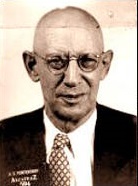

 finally, on November 23, 1959, it was decided that he could come out of solitary confinement. He stepped out of that cell for the first time since 1916…42+ years of solitary confinement. Of course, freedom from solitary confinement didn’t mean freedom from the prison. November 21, 1963, at the age of 73, with no cause of death, Robert “Birdman of Alcatraz” Stroud died at the Medical Center for Federal Prisoners in Springfield, Missouri.
finally, on November 23, 1959, it was decided that he could come out of solitary confinement. He stepped out of that cell for the first time since 1916…42+ years of solitary confinement. Of course, freedom from solitary confinement didn’t mean freedom from the prison. November 21, 1963, at the age of 73, with no cause of death, Robert “Birdman of Alcatraz” Stroud died at the Medical Center for Federal Prisoners in Springfield, Missouri.

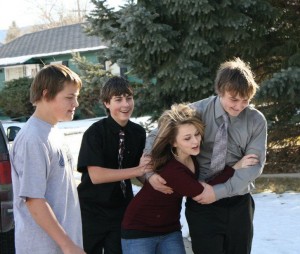 If I had to describe my granddaughter, Shai Royce, in one word, it would be bold. Shai isn’t afraid of anything, and she isn’t intimidated by anything or anyone. Not many people can say that about themselves, and not many people can live their lives in that kind of boldness either. Shai (no matter what her name makes you think) doesn’t have a shy bone in her body. She is outgoing, bubbly, and fun. It makes people want to be around her. She has a very magnetic personality.
If I had to describe my granddaughter, Shai Royce, in one word, it would be bold. Shai isn’t afraid of anything, and she isn’t intimidated by anything or anyone. Not many people can say that about themselves, and not many people can live their lives in that kind of boldness either. Shai (no matter what her name makes you think) doesn’t have a shy bone in her body. She is outgoing, bubbly, and fun. It makes people want to be around her. She has a very magnetic personality.
Shai was born on February 29th…a Leap Day Baby, and we absolutely love the uniqueness of that day in conjunction with her birthday. I don’t know that Shai always liked it, but I think for the most part, Shai, being our only granddaughter, felt picked on by the boys. They were all so close in age, and because she only got a “real” birthday every four years, the boys liked to tell  her that they were older than she was…even the younger ones, and especially her younger brother, Caalab Royce. These days, I don’t think she minds being told she is younger, and that will be a bigger and bigger blessing as the years go by. While Shai is technically 26 years old today, she is actually only 6½ years old today. She has been alive 26 years, but has only had 6 “real” birthdays, and she is halfway to the next real birthday. That may not seem great right now, but when she is 60 years old, she will actually only be 15 years old. What 60-year-old woman wouldn’t love that?? So, today is Shai’s Nano-Birthday again, because in the nano-second between 11:59pm and 12:00am this morning…her birthday happened. Maybe that’s why I like to say that “Leap Happens” when she actually gets a real birthday. The really cool thing is that she can celebrate for two days, because either one counts as her birthday in a Nano-Year. I know that Shai has and will be celebrating her birthday in a big way, because it is a big deal.
her that they were older than she was…even the younger ones, and especially her younger brother, Caalab Royce. These days, I don’t think she minds being told she is younger, and that will be a bigger and bigger blessing as the years go by. While Shai is technically 26 years old today, she is actually only 6½ years old today. She has been alive 26 years, but has only had 6 “real” birthdays, and she is halfway to the next real birthday. That may not seem great right now, but when she is 60 years old, she will actually only be 15 years old. What 60-year-old woman wouldn’t love that?? So, today is Shai’s Nano-Birthday again, because in the nano-second between 11:59pm and 12:00am this morning…her birthday happened. Maybe that’s why I like to say that “Leap Happens” when she actually gets a real birthday. The really cool thing is that she can celebrate for two days, because either one counts as her birthday in a Nano-Year. I know that Shai has and will be celebrating her birthday in a big way, because it is a big deal.
Shai has had an interesting year. She is an insurance agent with Rice Insurance in Bellingham, Washington, and after Covid and the accompanying lockdowns, Rice Insurance realized that their agents can easily and effectively work from home. They are an agency without walk in traffic, so having their agents in the office is not necessary. So, now both Shai and her mom, Amy 
 Royce, who is also an insurance agent with Rice Insurance, work from home, and they both really love it. The weather doesn’t matter to their commute, and that had been good this year, because oddly, they have had more snow than in many years past. Because they don’t get much snow, the roads are shut down when then get very much snow. The agents who work from home don’t miss a day of work. And the ones who don’t work from home can easily get going at home too when needed. It’s a win-win. Today is Shai’s Nano-Birthday. Happy 26th/6.5th birthday Shai!! Have a great day!! We love you!!
Royce, who is also an insurance agent with Rice Insurance, work from home, and they both really love it. The weather doesn’t matter to their commute, and that had been good this year, because oddly, they have had more snow than in many years past. Because they don’t get much snow, the roads are shut down when then get very much snow. The agents who work from home don’t miss a day of work. And the ones who don’t work from home can easily get going at home too when needed. It’s a win-win. Today is Shai’s Nano-Birthday. Happy 26th/6.5th birthday Shai!! Have a great day!! We love you!!
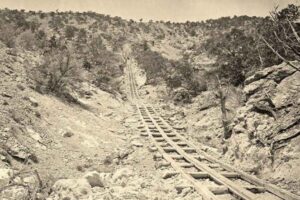 Gold mining was, without a doubt, a profitable business, but it wasn’t an easy business to be in, especially in the early days. The miners-turned-innovators had to figure out ways to speed work up in order to make a profit. Gold is a tricky metal to find and mine, as are most precious metals. One thing that was needed, especially in underground mining, was a way to get the ore out of the mine, and the tools and workers into the mine. It is a waste of time to have workers walking long distances into the mines., their tools are heavy, and carrying all that in makes for slow going…if the miners
Gold mining was, without a doubt, a profitable business, but it wasn’t an easy business to be in, especially in the early days. The miners-turned-innovators had to figure out ways to speed work up in order to make a profit. Gold is a tricky metal to find and mine, as are most precious metals. One thing that was needed, especially in underground mining, was a way to get the ore out of the mine, and the tools and workers into the mine. It is a waste of time to have workers walking long distances into the mines., their tools are heavy, and carrying all that in makes for slow going…if the miners  are walking anyway. A mine railway, also called mine railroad or sometimes pit railway, is a railway constructed to carry materials and workers in and out of a mine. Few people would remember, but the mix of heavy and bulky materials which had to be hauled into and out of mines gave rise to the first several generations of railways. The first rails, like this one, photographed in Illinois by Timothy O’Sullivan leading to a gold mine, was made of wooden rails. Eventually they added protective iron, steam locomotion by fixed engines and the earliest
are walking anyway. A mine railway, also called mine railroad or sometimes pit railway, is a railway constructed to carry materials and workers in and out of a mine. Few people would remember, but the mix of heavy and bulky materials which had to be hauled into and out of mines gave rise to the first several generations of railways. The first rails, like this one, photographed in Illinois by Timothy O’Sullivan leading to a gold mine, was made of wooden rails. Eventually they added protective iron, steam locomotion by fixed engines and the earliest 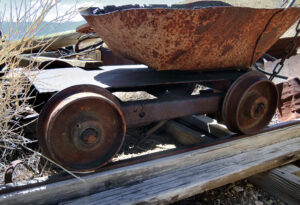 commercial steam locomotives. All these came about because of the mines.
commercial steam locomotives. All these came about because of the mines.
The old wooden rails worked very well. Gold carts, or ore cars, were moved up and down the railway using a pulley. The original design of these carts was used in Colorado mines in the late 1800s. The system even had a 360° operating turntable, which allowed the car to dump in any direction. The wheels were exclusive, with a curved five spoke cast iron design. Running the ore carts along the railway wasn’t easy either. There may have been a steam engine to work the pulley later on, but at first, it was all human muscle, and it wasn’t easy.








